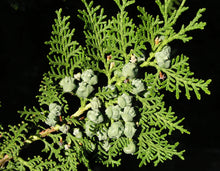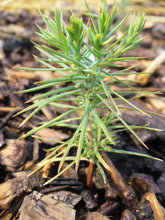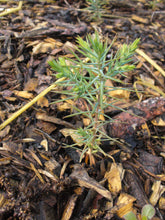Platycladus orientalis (aka Thuja Orientalis, Chinese Arborvitae, Blue Cone Arborvitae, etc) is one of the most interesting of all trees and it is one of our most favorite plants to grow.
Originating in China, where it's known as the "Tree of Life", the oldest living specimen is over 4,000 years old. Once established, these trees tolerate cold, heat, drought, wind, and crappy soil, and they are widely used for reforestation in China.
Platycladus produces weird-looking blue cones, the foliage contains Thujone (the active ingredient in Absinthe), and the roots contain up to 2.75% gasoline. The seeds are much larger than other thujas or cedars, and can be eaten after soaking or roasting to deactivate toxic compounds. On top of all that, Platycladus is used in traditional medicine to treat baldness.
Typically used in the US as a hedge plant, it is slow growing and tolerates shearing well. The foliage grows in upright parallel "plates" arranged kind of like plates in a dish rack, and the foliage is resistant to deer browsing. The foliage turns orange-brown-purple in the winter and then turns bright lime green in the spring. Additionally, the thick foliage grows tightly enough that it provides excellent protection for a variety of birds, and these trees are always full of birds even in areas with lots of cats around. And like all thujas, it produces lightweight, resilient, aromatic, and rot-resistant wood.
These are 6 to 16 inch 4th year seedlings.

Photo Credit: https://commons.wikimedia.org/wiki/File:Thuja-orientalis.jpg





